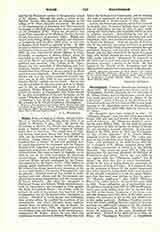

Walsingham THOMAS, Benedictine historian, d. about 1422. He is supposed to have been a native of Walsingham, Norfolk, England; he was educated at St. Albans Abbey, and having become a monk there was made precentor and placed in charge of the scriptorium. Little is known of his life beyond his historical work and the fact that in 1394 he was made superior of the dependent priory of Wymondham, where he remained until 1409, when he returned to St. Albans.
Six chronicles have been assigned to him: (I) “Chronica Majora”, now lost, but which was written before 1388 and was well known at that date as a work of reference. (2) “Chronicon Angliae”, covering the years 1328 to 1388. In this work the actions and character of John of Gaunt, the father of Henry IV, are somewhat severely criticized. It was published in the Rolls Series in 1874 (ed. Thompson). (3) The “Gesta Abbatum” of St. Albans Abbey, compiled between 1390 and 1394. The earlier portions of this record were taken largely from Matthew Paris. Also published in the Rolls Series, 1867-69. (4) A chronicle of St. Albans, compiled about 1393, the original manuscript of which is in the British. Museum. This covers the years 1272 to 1393, and incorporates the previous chronicles of Matthew of Westminster and others. Up to the year 1369 its text agrees with the “Chronicon Anglae” (no. 2 above), but after that date it varies considerably, chiefly in the way of toning down the aspersions on the character of John of Gaunt. It is supposed that on the accession of Henry IV the monks suppressed the earlier chronicle, being afraid of the consequences of the attacks contained in it on the king’s father, and that this work was written to take its place. (5)”Historia Anglicana”, also called “Historia Brevis” by earlier writers. It covers the years 1272 to 1422. Some authorities are of opinion that only the portion extending from 1377 to 1392 was Walsingham’s own work, basing their view on the fact that one MS. of the history terminates at the latter year, and also because after that date, in the other manuscripts, the narrative is not so full and satisfactory as the earlier portions. Professor Gairdner controverts this theory, holding that the defects of the later portions are sufficiently explained by the author’s removal to Wymondham in 1394. The style of the writer, he maintains, is the same throughout the entire work. Printed in the Rolls Series in 1863, ed. Riley. (6) “Ypodigma Neustriae”, a compilation intended to provide Henry V with a summary of the history of his predecessors, the dukes of Normandy, and partly borrowed from the “Historia Normannorum” of William of Jumieges. Published in the Rolls Series in 1876, ed. Riley.
As to the quality of Walsingham’s work, he was a collector of facts rather than an historian in the modern sense, painstaking and trustworthy, and to him we are indebted for the knowledge of many historical incidents not mentioned by other writers. He is, for instance, our chief authority for the reigns of Richard II, Henry IV, and Henry V, for the particulars of Wat Tyler’s insurrection of 1381, and for much that is known about Wyclif and the Lollards.
G. CYPRIAN ALSTON

